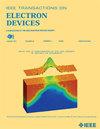A Data-Driven Remaining Useful Life Prediction Method for Power MOSFETs Considering Nonlinear Dynamical Behaviors
IF 2.9
2区 工程技术
Q2 ENGINEERING, ELECTRICAL & ELECTRONIC
引用次数: 0
Abstract
Prognostic and health management (PHM) techniques for power MOSFETs are getting increasing attention recently. A variety of methods have been developed and implemented to conduct lifetime predictions for power MOSFETs. Nevertheless, most of the current studies seem to have limitations in a comprehensive understanding of the nonlinear dynamical degradation process. Single parameter-oriented prediction methods may ignore deeper dynamical behaviors during the degradation. Besides, the methods are incapable of tackling abnormal degradation paths such as a sudden rise. In view of the limitations, a data-driven prediction method taking into consideration the nonlinear dynamical behaviors is developed. To analyze nonlinear and chaotic properties, phase space reconstruction (PSR) is conducted on the time series degradation data. Then, the largest Lyapunov exponent and power spectrum are calculated against aging time. The evolution of nonlinear and chaotic behaviors during the degradation is investigated. Thereby, a novel health indicator (HI) taking into account nonlinear indices is constructed. Subsequently, a prediction method based on a long short-term memory (LSTM) network is proposed. The developed method is validated by an actual degradation dataset. The results show that the developed method is capable of addressing the limitations with desirable accuracies.考虑非线性动力学行为的功率mosfet剩余使用寿命预测方法
功率场效应管的预后和健康管理(PHM)技术近年来受到越来越多的关注。已经开发和实施了各种方法来进行功率mosfet的寿命预测。然而,目前的大多数研究似乎在全面理解非线性动力退化过程方面存在局限性。面向单参数的预测方法可能会忽略退化过程中更深层次的动力学行为。此外,该方法无法处理异常的退化路径,如突然上升。针对这种局限性,提出了一种考虑非线性动力学行为的数据驱动预测方法。为了分析系统的非线性和混沌特性,对时间序列退化数据进行了相空间重构。然后,根据老化时间计算最大李雅普诺夫指数和功率谱。研究了退化过程中非线性和混沌行为的演化。由此,构造了一种考虑非线性指标的新型健康度指标。随后,提出了一种基于长短期记忆(LSTM)网络的预测方法。通过实际退化数据集验证了该方法的有效性。结果表明,所开发的方法能够以理想的精度解决这些限制。
本文章由计算机程序翻译,如有差异,请以英文原文为准。
求助全文
约1分钟内获得全文
求助全文
来源期刊

IEEE Transactions on Electron Devices
工程技术-工程:电子与电气
CiteScore
5.80
自引率
16.10%
发文量
937
审稿时长
3.8 months
期刊介绍:
IEEE Transactions on Electron Devices publishes original and significant contributions relating to the theory, modeling, design, performance and reliability of electron and ion integrated circuit devices and interconnects, involving insulators, metals, organic materials, micro-plasmas, semiconductors, quantum-effect structures, vacuum devices, and emerging materials with applications in bioelectronics, biomedical electronics, computation, communications, displays, microelectromechanics, imaging, micro-actuators, nanoelectronics, optoelectronics, photovoltaics, power ICs and micro-sensors. Tutorial and review papers on these subjects are also published and occasional special issues appear to present a collection of papers which treat particular areas in more depth and breadth.
 求助内容:
求助内容: 应助结果提醒方式:
应助结果提醒方式:


